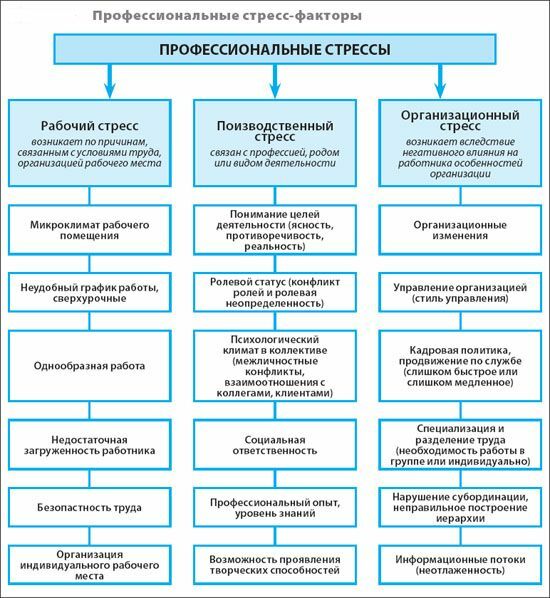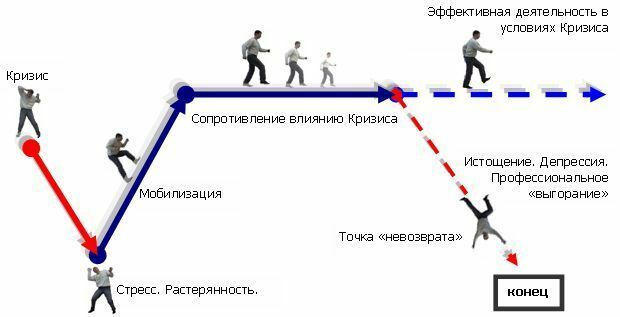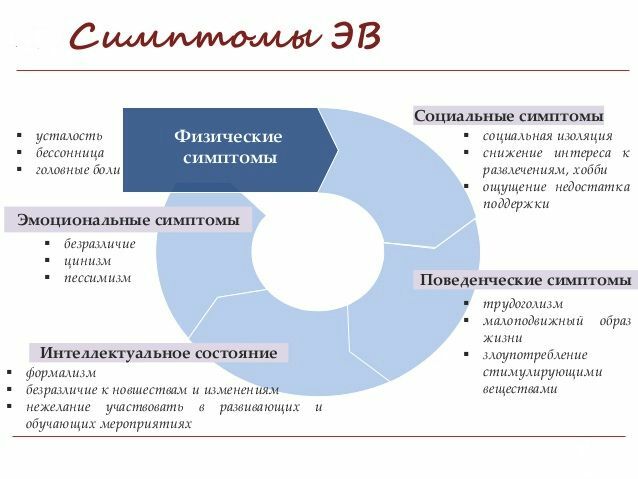Syndrome of emotional burnout: prevention and treatment

Recently, more often in the media, you can find references to the syndrome of emotional burnout.This is nothing more than an emotional exhaustion caused by the prolonged impact on a person of occupational stress.The syndrome is registered among the people of the communicative professions: teachers, social workers, psychologists, medics, sales agents, and account managers.
Table of contents: Causes Symptoms Consequences of the syndrome Diagnosis Treatment Prevention of emotional burnoutReasons for
Everyone is exposed to emotional burnout.
The development of emotional overstrain is affected both by the objective external circumstances of the working environment and by the personality characteristics of the individual.
Factors relating to the personal characteristics of a person include:
- Professional experience;
- Workaholic;
- Orientation to the result;
- The desire to control everything;
- Idealized expectations from work and life in general;
- Characteristics of the character( anxiety, rigidity, neuroticism, emotional lability).
External factors include:
- Excessive workload;
- Monotony of work activity;
- Responsibility for the results of the work performed;
- Unregulated schedule;
- Information load;
- Interpersonal conflicts;
- Lack of proper moral and material compensation for the performance of work;
- Need to work with a heavy contingent of clients( patients, students);
- Emotional involvement in the problems of clients( patients, students);
- Unsatisfactory situation in the collective and in society;
- No time to rest;
- High competition;Constant criticism, etc. .Stress, including professional, develops in three stages:
- The first is the stage of anxiety, when human defense mechanisms are mobilized.

If a huge amount of work has fallen upon a person, it accumulates and begins to work beyond the power to carry out the task entrusted.
- The second is the stage of resistance, when a person tries to adapt to the action of a stressor factor.However, when the adaptive ability of a person to overcome a stressful situation is exceeded, a third stage develops.
- The third is depletion, which is regarded as a manifestation of CMEA.

- Physical symptoms - fatigue, headache, dizziness, sweating, muscle trembling, sleep disorders, dyspeptic disorders, fluctuations in blood pressure, weight changes, dyspnea, meteosensitivity.
- Emotional symptoms - pessimism, cynicism, feelings of helplessness and hopelessness, anxiety, depressed mood, irritability, feelings of loneliness, feelings of guilt.
- Changes in the intellectual sphere - loss of interest in obtaining new information, loss of interest in life, lack of desire to diversify their leisure.
- Behavioral symptoms - a long working week, fatigue when performing work duties, the need to make frequent breaks in work, indifference to food, addiction to alcohol, nicotine, impulsive behavior.
- Social symptoms - lack of desire to participate in public life, poor communication with colleagues and relatives, isolation, a sense of lack of understanding by others, a sense of lack of moral support.
Symptoms
The structure of CMEA is divided into three fundamental components: emotional exhaustion, depersonalization, reduction of professional achievements.
Emotional exhaustion of is expressed by a feeling of fatigue, devastation.Emotions become faded, people feel that they can not feel the range of feelings that they used to.In general, in the professional sphere( and then in the personal sphere) negative emotions prevail: irritability, depression.
The depersonalization of is characterized by the perception of people rather than as individuals, but as objects, communication with which occurs without emotional involvement.Attitudes towards clients( patients, students) become soulless, cynical.Contacts become formal and impersonal.
 The reduction of professional achievements is characterized by the fact that a person begins to doubt his professionalism.Achievements and successes in the workplace seem insignificant, and career prospects are unreal.Appearance of indifference to work.
The reduction of professional achievements is characterized by the fact that a person begins to doubt his professionalism.Achievements and successes in the workplace seem insignificant, and career prospects are unreal.Appearance of indifference to work.
Syndrome of emotional burnout invariably affects not only the professionalism of a person, but also mental and physical health.
Thus, it is common to distinguish several groups of symptoms characteristic of CMEA:

Consequences of the syndrome
Why so much attention is paid to this syndrome? The whole point is that the CMEA has serious consequences, such as:
-
 Decreased efficiency, deterioration of work quality;
Decreased efficiency, deterioration of work quality; - Deformation of the person( depression, chronic fatigue, isolation);
- Impairment of interpersonal relationships( problems in the family);
- Psychosomatic diseases( arterial hypertension, myocardial infarction, bronchial asthma, peptic ulcer disease);
- Dependency development;
- Suicidal tendencies.
In general, CMEA can be perceived as a kind of psychological defense mechanism.Complete or partial deactivation of emotions in response to the effect of the stress factor makes it possible to economize the available energy resources.
Diagnostics
To identify the syndrome of emotional burnout, the degree of its severity, all kinds of questionnaires are used.
The main methods used to study CMEA:
- Diagnostics of emotional burnout Boyko V.V.("Diagnosis of the level of emotional burnout");
- Methodology A.A.Rukavishnikova "Definition of mental burnout";
- Methodology "Estimation of own burn-out potential";
- Methodology K. Maslach and S. Jackson "Professional( emotional) burnout( MBI)".
Treatment
There is no universal panacea for the syndrome of emotional burnout.But to underestimate the problem is not worth it, it can lead to deterioration of health and quality of life in general.
If you notice the signs of CMEA, try to implement the following recommendations:
-
 From time to time take breaks.Look at your life from the outside.What do you strive for?Are you on the right track, do you need everything that you are doing now?
From time to time take breaks.Look at your life from the outside.What do you strive for?Are you on the right track, do you need everything that you are doing now? - Try to switch to related professional activities.This step can open new horizons.
- Master those aspects of your work that seem incomprehensible and complex.This will bring the feeling of something new, help restore interest in the profession.
- Take a vacation and change the situation.
With a marked emotional burnout syndrome, you should consult a therapist. The physician can use the following approaches:
- Psychotherapy( cognitive-behavioral, client-centered, training in relaxation techniques, conducting communication skills, raising emotional intelligence, self-confidence);
- Medical therapy( appointment of antidepressants, anxiolytics, hypnotics, beta-blockers, nootropics).
It is important to allow a person to discuss emotions after a critical event.This can be done both at individual meetings with a psychologist, and at joint meetings with colleagues.
Discussions of the event allow a person to express their emotions, experiences, aggression.In addition, such an approach will help a person to realize their stereotypes of action, to see their inefficiency, to develop adequate ways of responding to all sorts of stressful situations, to learn how to resolve conflicts and build productive relations with colleagues.
If CMEA can not be corrected by available methods and there is a persistent negative attitude towards clients( patients), colleagues, one should think about the alternative to changing jobs, switching to activities that are not related to people.
Prevention of emotional burnout
It is impossible to completely exclude the influence of stressors on our lives.But you can learn to respond to them correctly and not allow emotional exhaustion.
The following recommendations can be assigned to preventive measures:
-
 Set short-term as well as long-term goals.The fulfillment of short-term goals brings a sense of moral satisfaction, and therefore, gives an incentive to continue work.In order to achieve long-term goals achievable, it is necessary to describe the fulfillment of the task in stages.
Set short-term as well as long-term goals.The fulfillment of short-term goals brings a sense of moral satisfaction, and therefore, gives an incentive to continue work.In order to achieve long-term goals achievable, it is necessary to describe the fulfillment of the task in stages. - Boost your professional level.Take part in conferences, communicate with colleagues from other organizations, share experiences.
- Do not forget about the rest.Take breaks during work.Free time and weekend use for recreation and hobbies.Alternation of work with rest will allow to carry out professional activity more effectively.
- Learn the techniques of relaxation and autoregulation.
- Do not be afraid to share your experiences with loved ones.It is your family and loved ones that will help you cope with the experiences.
- Do not bring a dream for the sake of the profession.During sleep, "unloading" of the psyche occurs.
- Go in for sports, watch your food.Remember that the somatic state has a strong influence on mental state.
- Find a hobby.Interests outside of work will allow to remove tension, to distract from troubles.
- Avoid unnecessary competition.
- Try not to get involved excessively in the problems of clients( patients, students).
- Remember, it's impossible to catch everything.Soberly assess their capabilities.
- Do not try to control everything.There are circumstances that are beyond our control.
Grigorova Valeria, medical reviewer



